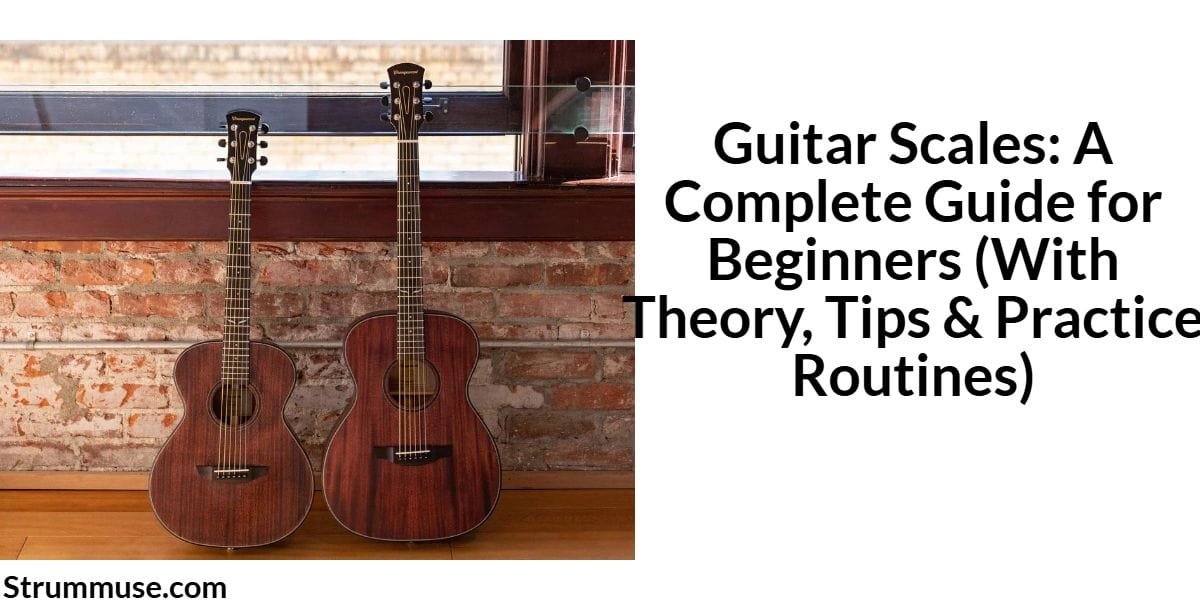
Whether you’re a beginner guitarist or someone looking to build a strong foundation, understanding guitar scales is essential for mastering melody, improvisation, and soloing. In this humanised, SEO-optimised and AdSense-friendly guide, we’ll explore what guitar scales are, how to learn and practice them, their different types, and how they can truly transform your playing journey.
🎸 What Are Guitar Scales?
A guitar scale is a sequence of musical notes played in ascending or descending order. Think of scales as musical DNA – they form the structure behind chords, melodies, and solos.
Scales follow patterns of intervals (whole and half steps) and provide the roadmap to play in key. Understanding them gives you the freedom to improvise and write music across any genre – be it Bollywood, classical, or rock.
Whether you’re strumming your first chords or composing instrumentals, scales will shape your understanding of guitar.
🧠 Why Should Beginners Learn Scales?
Here’s why every beginner should include scales in their practice:
- ✅ Improves finger strength & coordination
- ✅ Builds speed and accuracy
- ✅ Trains your ears (ear training)
- ✅ Unlocks melody and soloing freedom
- ✅ Enhances music theory understanding
Learning scales is like learning a new language – it may seem technical at first but opens creative freedom.
“When I started out, I didn’t understand why scales mattered. But once I started composing melodies, I realised scales were the key to everything musical.”
🎯 10 Must-Know Guitar Scales for Beginners
Understanding different types of scales gives you more creative tools. Let’s break them down:
1. Major Scale
- Bright, happy and natural sound
- Formula: W-W-H-W-W-W-H
- Example: C Major = C – D – E – F – G – A – B – C
- Common in: Pop, Bollywood, Indian Raag Bhupali
2. Natural Minor Scale
- Emotional, intense or sad feel
- Formula: W-H-W-W-H-W-W
- Example: A Minor = A – B – C – D – E – F – G – A
- Common in: Bollywood ballads, Indian Raagas like Bhairavi
3. Harmonic Minor Scale
- Exotic and classical sound
- Formula: W-H-W-W-H-W+H-H
- Example: A Harmonic Minor = A – B – C – D – E – F – G# – A
4. Melodic Minor Scale
- Complex, used in jazz & Indian classical
- Ascending: W-H-W-W-W-W-H
- Descending: Natural Minor
5. Pentatonic Major Scale
- Simple 5-note scale
- C Major Pentatonic: C – D – E – G – A
- Great for melodies and riffs
6. Pentatonic Minor Scale
- Most used in guitar solos
- A Minor Pentatonic: A – C – D – E – G
7. Blues Scale
- Adds a flat fifth or “blue note”
- A Blues Scale: A – C – D – D# – E – G
- Perfect for soulful solos
8. Dorian Mode
- Minor mode with a twist
- Often used in film scores and classical fusion
9. Phrygian Mode
- Dark, Spanish/Flamenco sound
- Common in Bollywood thrillers and suspense
10. Lydian Mode
- Dreamy and open
- Same as Raag Yaman in Indian classical
🗺️ How to Learn and Practice Scales (Step-by-Step)
- Start with One Position – Focus on 5th or 8th fret shapes
- Use a Metronome – Begin slow (40-60 BPM) then increase
- Use Alternate Picking – Down-Up for every note
- Train Both Directions – Ascending & descending
- Practice with Backing Tracks – Helps apply scales musically
- Jam with Each Scale – Compose a lick or riff after each session
🔁 Tip: Stick to one scale per week and apply it across different keys.
🧪 Theory Behind the Scales
Each scale is built from intervals. Here’s a quick table:
| Scale Type | Pattern (W=Whole, H=Half) | Notes (in C) |
|---|---|---|
| Major Scale | W-W-H-W-W-W-H | C D E F G A B C |
| Minor Scale | W-H-W-W-H-W-W | A B C D E F G A |
| Blues Scale | W+H-W-H-H-W+H-W | C D# F F# G A# C |
| Pentatonic Minor | W+H-W-W-W+H-W | A C D E G A |
| Harmonic Minor | W-H-W-W-H-W+H-H | A B C D E F G# A |
🎵 Scales in Bollywood & Indian Classical
You’ll be surprised how much Bollywood relies on these scales:
| Song | Scale/Raag Equivalent |
|---|---|
| Tum Hi Ho | A Minor / Raag Bhairavi |
| Kal Ho Na Ho (Title Track) | C Major / Raag Bhupali |
| Kabira | A Minor Pentatonic |
| Agar Tum Saath Ho | D Harmonic Minor |
| Raga Yaman (instrumentals) | Lydian |
Understanding these relationships helps you play Indian songs with emotion and depth.
🛠️ Practice Routine (15 Minutes a Day)
Here’s a beginner routine to follow:
- 5 min – One scale slow tempo (e.g., A Minor)
- 3 min – Ascend and descend with alternate picking
- 4 min – Improvise short melody
- 3 min – Apply scale over backing track or chords
You can expand to 30 or 45 minutes once comfortable.
🧑🎓 Author’s Note: My Journey with Scales
When I began playing, scales felt mechanical. I didn’t realise their real value until I joined a band. While jamming, I often fumbled when soloing. That’s when I took scales seriously.
Now, scales are my creative playground. I improvise on Raag Yaman, compose over minor pentatonic shapes, and use blues scale for rock vibes. Trust me, scales make your guitar journey exciting and musical.
🔗 Recommended Posts from StrumMuse
A Major Scale
B Major Scale
C Major Scale
D Major Scale
E Major Scale
F Major Scale
G Major Scale
A Minor Scale
B Minor Scale
C Minor Scale
D Minor Scale
E Minor Scale
F Minor Scale
G Minor Scale
🧩 Conclusion
Scales might feel theoretical at first, but they’re actually the foundation of all music on guitar. Whether you want to solo over your favourite Bollywood song or jam with friends, mastering scales gives you musical confidence.
Keep exploring, keep playing, and trust the process. 🎸
